QuestionQUESTION: I have an adult male green anole lizard named Sheldon who lives in a big glass cage with three female lizards. The cage is outside and the temperature stays between 95 and 60 degrees. Half of it is in the shade, and the other half is in the sun. They all have plenty of sticks, leaves, food (waxworms), and water. About a two weeks ago, a male lizard on the outside of the cage began harassing Sheldon, puffing up at him and flashing his dewlap. They can't get to each other, but Sheldon tries to attack through the glass. I've attempted getting rid of the wild lizard countless times, but he keeps coming back and I don't want to hurt him. About a week ago, I went outside and noticed that part of Sheldon's spine is sticking up. It's right above where his tail starts. It doesn't seem to be causing him any pain and he walks fine, but it looks painful. His behavior is completely normal, and he's even mating with the females. (I found an egg this morning.) I think he hurt it somehow trying to fight the lizard outside the cage, but I'm unsure. Is there a way I can fix it without injuring him further? Do I need to fix it, or will it fix itself in time?
Any advice will be appreciated. Thank you.
P.S. Any additional advice about the egg would be great!
ANSWER: I'm actually surprised you're able to keep the temperature in the cage below lethal levels, since it's glass -- glass tends to magnify sunlight that passes through it, creating enormous heat buildup. Glass cages should never be in the sun.
I recommend improving the lizards' diet - wax worms are high in fat, and are suitable only as an occasional treat. If the females are laying eggs, it's especially important that they have excellent nutrition. Phoenix worms (completely different) are a decent dietary staple, as are 1/4 inch crickets - crickets should be dusted with calcium powder.
If there is no unfiltered sunlight in the cage (glass filters out UVB), they will need D3 supplements as well. Being outdoors in florida, mesh would be best for the majority of the cage - it would allow natural basking. Avoid fine screen which could trap toenails, or nylon which predators might tear through.
It's really quite difficult to determine what you're talking about when you say that part of his spine is sticking up. A photograph would be needed before I could even guess.
Large adult male anoles can develop an erectile ridge of flesh along their back - this is used to make them look larger in displays. I'm not certain whether this might be what you are talking about.
http://otterside.com/spring2009/lizard-1002.jpg
---------- FOLLOW-UP ----------
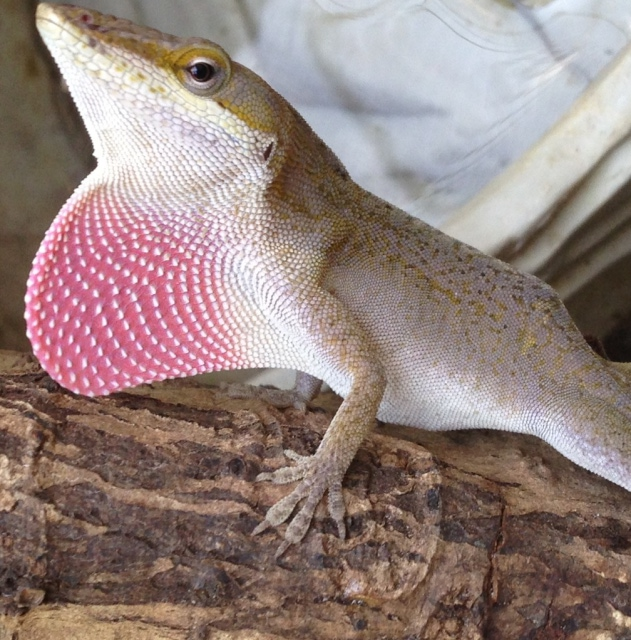 Lizard back problem
Lizard back problem
QUESTION: Thank you for that advice.
I've seen that ridge before, but that isn't what I'm talking about. I have a picture. Notice, in the picture, he is flashing his dewlap, but his back sticks up constantly, not just when he is trying to mate. He appears to be okay otherwise.
ANSWER: It certainly does appear he's broken his back, and he's very lucky not to have suffered any impairment in his back legs and tail as a result of it. There is probably nothing a veterinarian can do for him - attempting to set the break could damage his spinal cord.
As for the egg, you can either allow it to incubate in situ (where the female buried it), or you can incubate it artificially, in a chicken egg incubator. An inexpensive still air model Hovabator works well. It will take some practice and tweaking to set the thermostat properly. You'll need a digital thermometer with a remote probe.
Get some vermiculite, and moisten it with water until it holds together when squeezed (but you can't wring any water out of it). Put this in a deli cup, and put the eggs in it, with the lid on. Place the deli cup in the incubator. Anole eggs should hatch in four to six weeks at 83F. The temperature can range from 80 to 85F. Try to stay in that range, as wandering too far outside of the safe temperature range can lead to deformities in the embryo. It's a bit of work and expense for anole eggs, but hatching them separately will help ensure that the adults don't eat the hatchlings.
Don't overestimate the size of a newly hatched anole. They are incredibly tiny, and they'll need an escape-proof enclosure of their own. They feed on pinhead (newborn) crickets and fruit flies - dust insects with calcium powder. They need the same environment as the adults.
If you found the egg not buried in soil, chances are less that it is fertile. (Always be sure females have moist moss or soil to bury their eggs). You'll know in about a week - it will either remain plump as it absorbs moisture, or it will sink and collapse. Only a living embryo will draw moisture in, so dead eggs dessicate and collapse, or mold.
---------- FOLLOW-UP ----------
QUESTION: So should I just leave him alone?
Thank you. I needed that. I had probably 15 eggs last year total and a very low hatching rate. Only four babies hatched. They are incredibly adorable. Maybe I'll have a higher hatching rate this year.
But is there a way I can do it without having to move the eggs? I think that may have been another problem from last year. I had to move EVERY egg that I found. I tried my hardest not to turn them, and I was successful aside from about two eggs. It just makes me too nervous. I freaked out when I found the one egg the other day. I did move it into a container with very good conditions (moist soil and warm temperature) and it appears fertile. It did not turn. It's been there for a few days. I check on it at least once a day to make sure it isn't moldy.
AnswerYes; I'd keep an eye on him, but I don't think there's anything to be done. Be sure to improve their diet - lack of calcium can cause weak bones, increasing the risk of injuries like that. Most feeder insects need to be supplemented with calcium dust, and unless there's access to unfiltered sunlight, vitamin D3 as well. Proper nutrition also contributes to healthy hatchlings - eggs laid by malnourished females won't fare as well.
Eggs need proper temperatures, and proper humidity. The bit about not turning them is actually a myth. Folks theorized that turning the eggs would be harmful, and somehow it turned from theory into fact as it was passed around. A few people tested it, with clutches of leopard gecko eggs, and there was no effect from turning the eggs at all.
So, while no in-depth, large scale tests have ever been done, there is most likely no need to worry about accidentally turning the eggs. I certainly don't fuss over it too much with my ball pythons.
I recommend checking on the egg only once a week. Every time it's uncovered, the temperature changes, so it's best to let it be.


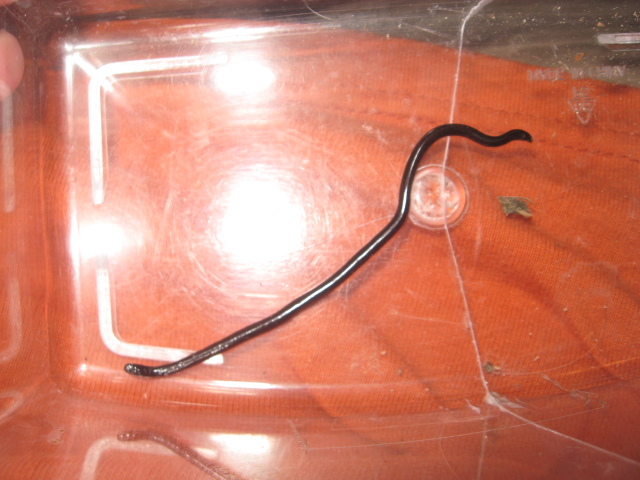 Small Black Snake/Worm
Question
Snake/Worm
Hello, my sisters were in the backy
Small Black Snake/Worm
Question
Snake/Worm
Hello, my sisters were in the backy
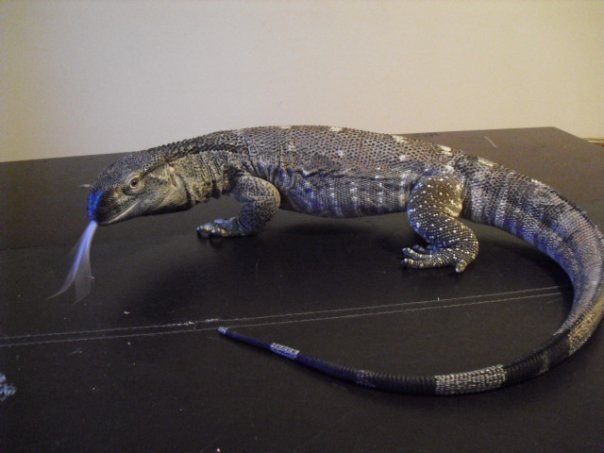 Is salt water ok?
QuestionQUESTION: Hi, Im moving to the coast in a coupl
Is salt water ok?
QuestionQUESTION: Hi, Im moving to the coast in a coupl
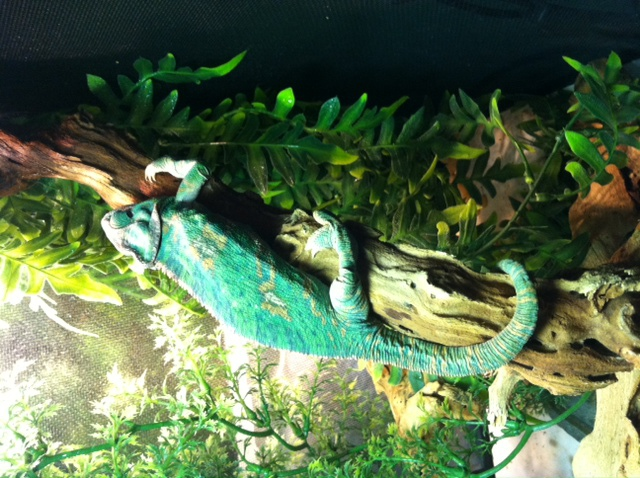 1 year old female veiled chameleon
QuestionLizzy
Lizzys Setup
QUESTION: I ha
1 year old female veiled chameleon
QuestionLizzy
Lizzys Setup
QUESTION: I ha
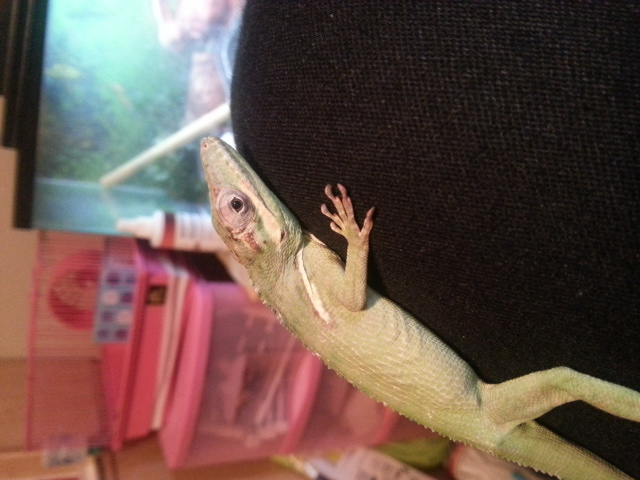 Cuban Knight Anole
Question
Grimm
Hello! I have a four month old Kn
Cuban Knight Anole
Question
Grimm
Hello! I have a four month old Kn
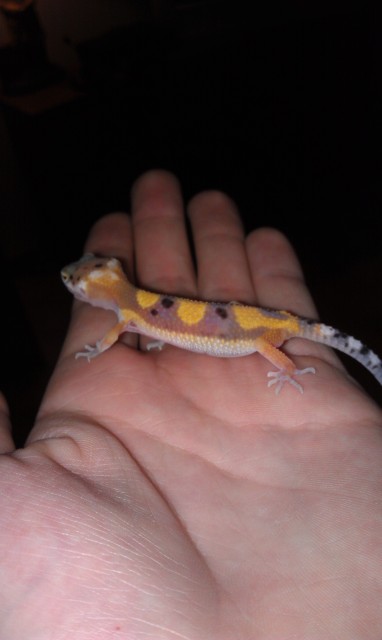 Vomiting Gecko
QuestionQUESTION: Hey Tracie,
Its Sean sorry I couldnt
Vomiting Gecko
QuestionQUESTION: Hey Tracie,
Its Sean sorry I couldnt